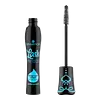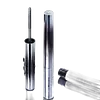Essence Lash Princess False Lash Effect Waterproof Mascara Versus Judydoll 3D Curling Eyelash Iron Mascara
What's inside
What's inside
 Key Ingredients
Key Ingredients

 Benefits
Benefits

 Concerns
Concerns

 Ingredients Side-by-side
Ingredients Side-by-side

Isododecane
EmollientCera Microcristallina
Emulsion StabilisingWater
Skin ConditioningVp/Eicosene Copolymer
Euphorbia Cerifera Wax
Trimethylsiloxysilicate
EmollientTalc
AbrasiveCopernicia Cerifera Wax
Disteardimonium Hectorite
StabilisingPropylene Glycol
HumectantSilica
AbrasiveSorbitan Isostearate
EmulsifyingPanthenol
Skin ConditioningSimmondsia Chinensis Seed Oil
EmollientTocopherol
AntioxidantPropylene Carbonate
SolventTrimethyl Pentanyl Diisobutyrate
Ethylhexylglycerin
Skin ConditioningPhenoxyethanol
PreservativePotassium Sorbate
PreservativeCI 77499
Cosmetic ColorantIsododecane, Cera Microcristallina, Water, Vp/Eicosene Copolymer, Euphorbia Cerifera Wax, Trimethylsiloxysilicate, Talc, Copernicia Cerifera Wax, Disteardimonium Hectorite, Propylene Glycol, Silica, Sorbitan Isostearate, Panthenol, Simmondsia Chinensis Seed Oil, Tocopherol, Propylene Carbonate, Trimethyl Pentanyl Diisobutyrate, Ethylhexylglycerin, Phenoxyethanol, Potassium Sorbate, CI 77499
Isododecane
EmollientTrimethylsiloxysilicate
EmollientDextrin Palmitate
EmulsifyingMicrocrystalline Wax
Emulsion StabilisingCeresin
Emulsion StabilisingPolypropylsilsesquioxane
Paraffin
PerfumingBenzalkonium Montmorillonite
EmulsifyingHydrogenated Polyisobutene
EmollientSynthetic Wax
AbrasiveRayon
CI 77491
Cosmetic ColorantCI 77499
Cosmetic ColorantCI 77007
Cosmetic ColorantPropylene Carbonate
SolventSilica
AbrasivePolymethylsilsesquioxane
Phenethyl Alcohol
MaskingCaprylic/Capric Glycerides Polyglyceryl-10 Esters
EmollientCI 77492
Cosmetic ColorantMica
Cosmetic ColorantCI 75470
Cosmetic ColorantTriethoxycaprylylsilane
CI 77266
Cosmetic ColorantPanthenol
Skin ConditioningBHT
AntioxidantIsododecane, Trimethylsiloxysilicate, Dextrin Palmitate, Microcrystalline Wax, Ceresin, Polypropylsilsesquioxane, Paraffin, Benzalkonium Montmorillonite, Hydrogenated Polyisobutene, Synthetic Wax, Rayon, CI 77491, CI 77499, CI 77007, Propylene Carbonate, Silica, Polymethylsilsesquioxane, Phenethyl Alcohol, Caprylic/Capric Glycerides Polyglyceryl-10 Esters, CI 77492, Mica, CI 75470, Triethoxycaprylylsilane, CI 77266, Panthenol, BHT
 Reviews
Reviews

Ingredients Explained
These ingredients are found in both products.
Ingredients higher up in an ingredient list are typically present in a larger amount.
Ci 77499 is also hydrated iron III oxide. It is created from mixing red and black iron oxides. This helps give shades of darkness to a product.
Iron III oxides are classified as inorganic chemicals for coloring.
Isododecane is a fragrance, emollient, and solvent.
As an emollient, it helps your skin stay soft and hydrated. Emollients help trap moisture into your skin.
Isododecane's role as a solvent makes it a great texture enhancer. It spreads smoothly on skin and does not leave a sticky feeling behind. Isododecane also helps prevent color transfer in makeup products.
Isododecane is not absorbed into skin.
Learn more about IsododecanePanthenol is a common ingredient that helps hydrate and soothe the skin. It is found naturally in our skin and hair.
There are two forms of panthenol: D and L.
D-panthenol is also known as dexpanthenol. Most cosmetics use dexpanthenol or a mixture of D and L-panthenol.
Panthenol is famous due to its ability to go deeper into the skin's layers. Using this ingredient has numerous pros (and no cons):
Like hyaluronic acid, panthenol is a humectant. Humectants are able to bind and hold large amounts of water to keep skin hydrated.
This ingredient works well for wound healing. It works by increasing tissue in the wound and helps close open wounds.
Once oxidized, panthenol converts to pantothenic acid. Panthothenic acid is found in all living cells.
This ingredient is also referred to as pro-vitamin B5.
Learn more about PanthenolThis ingredient is a solvent. It helps dissolve active ingredients and alter the texture of products.
Propylene Carbonate is commonly used in makeup and with clay, such as montmorillonite or bentonite.
Studies show this ingredient to be safe for cosmetics. When it is undiluted, it can cause skin irritation. (It is always diluted in skincare and makeup). This ingredient is water-soluble.
Propylene Carbonate is created from propylene glycol and carbonic acid.
Learn more about Propylene CarbonateSilica, also known as silicon dioxide, is a naturally occurring mineral. It is used as a fine, spherical, and porous powder in cosmetics.
Though it has exfoliant properties, the function of silica varies depending on the product.
The unique structure of silica enhances the spreadability and adds smoothness, making it a great texture enhancer.
It is also used as an active carrier, emulsifier, and mattifier due to its ability to absorb excess oil.
In some products, tiny microneedles called spicules are made from silica or hydrolyzed sponge. When you rub them in, they lightly polish away dead skin layers and enhance the penetration of active ingredients.
Learn more about SilicaThis silicone is an emollient. Emollients create a thin film on the skin to prevent moisture from escaping.
It is not soluble in water and helps increase water-resistance in products.
According to a manufacturer, it can blend seamlessly with silicone oils, such as Cyclopentasiloxane.
Learn more about Trimethylsiloxysilicate